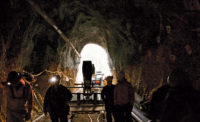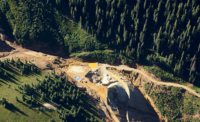EPA assumed stewardship of the mine when the agency demanded access four years ago, Hennis says. “But it’s wrong they’ve been saddled with what should have been Sunnyside’s responsibility,” she adds.
Sunnyside officials disagree with Hennis. “This was very unfortunate, and EPA Administrator Gina McCarthy has stated that the [agency] does take full responsibility for this incident,” says Kevin Roach, reclamation director for Sunnyside Gold, in an emailed statement to ENR following the spill. “Sunnyside understands that the buildup may have been caused by recent blockage of the Gold King portal.”
Gold King’s mine shaft had collapsed, says Butler. “EPA’s been trying to get in there and open it back up since last fall, but when they started excavating some of the loose material, they had no idea that the water buildup was that high,” he points out. The disaster has called into question not only EPA’s mine reclamation expertise of the but also the engineering solutions applied to trap mountain flows through mines, which become toxic, and then discharge into local rivers and streams. “EPA should have been talking more,” Butler says. “If they had been working with people who have the experience with these mines, this probably wouldn’t have happened.”
Burden of Proof
However, Butler says no one can prove, that the water buildup in the Gold King Mine came from the Sunnyside retention pools. Nevertheless, EPA in January said there was a flow of approximately 300 gallons per minute at the site after the Sunnyside plugging project. Combined with the closure of the Sunnyside water treatment plant in Silverton, Colo., “water quality in the Animas River has degraded,” EPA said.
Some mining engineers claim that plugging a mine causes the tainted water to back up, where it can be neutralized. Others counter that the mine’s wastewater will drain through other openings across fragile ecosystems. The second scenario is what happened at Sunnyside, Hennis believes.
Sunnyside’s Roach says the bulkheads were installed to isolate its mine workings from others in the area and prevent acid mine wastewater from flowing to the Animas Basin.
“Unlike the Gold King earthen plug, the bulkheads installed at Sunnyside are engineered concrete structures. While the state-approved bulkheading was always expected to return the local water table to historic natural levels, it did not cause the water buildup at Gold King,” according to Roach.
Gold King Mine, not Sunnyside, is where the breach occurred, Roach says. “Since Sunnyside’s closure in 1991, the company has met all its regulatory environmental requirements and has complied with all the terms of its reclamation permit,” he says.




Post a comment to this article
Report Abusive Comment